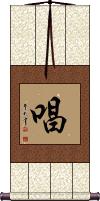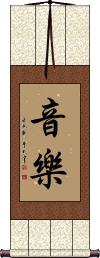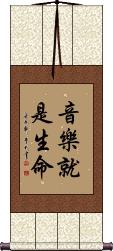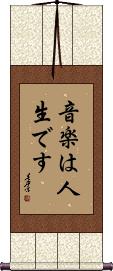Many custom options...
And formats...

Sing in Chinese / Japanese...
Buy a Sing calligraphy wall scroll here!
Personalize your custom “Sing” project by clicking the button next to your favorite “Sing” title below...
Sing / Singing
唱 is how to refer to singing or song in Chinese.
In Japanese, the meaning is similar but more closely means chant, recite or yell. Best if your audience is Chinese.
Musician
音樂家 is how to write “musician” in most Asian languages.
There is more than one way to express “musician” in China, but this is the traditional and most respectful title.
![]() The second character has morphed a bit in Japanese Kanji. If you want the specifically modern Japanese version, please click on the Kanji to the right, instead of the button above. The version shown to the left was used in ancient Japan, prior to the Japanese language reformations after WWII (so technically,
it’s
still Japanese).
The second character has morphed a bit in Japanese Kanji. If you want the specifically modern Japanese version, please click on the Kanji to the right, instead of the button above. The version shown to the left was used in ancient Japan, prior to the Japanese language reformations after WWII (so technically,
it’s
still Japanese).
Music
音樂 is how to write music in most Asian languages.
It can also express the idea of a musical movement, depending on context.
![]() The second character has morphed a bit in Japanese Kanji. If you want the specifically modern Japanese version, please click on the Kanji to the right, instead of the button above. The version shown to the left was used in ancient Japan, prior to the Japanese language reformations after WWII (so technically,
it’s
still Japanese).
The second character has morphed a bit in Japanese Kanji. If you want the specifically modern Japanese version, please click on the Kanji to the right, instead of the button above. The version shown to the left was used in ancient Japan, prior to the Japanese language reformations after WWII (so technically,
it’s
still Japanese).
Music is Life
Music is Life
This in-stock artwork might be what you are looking for, and ships right away...
Gallery Price: $126.00
Your Price: $69.88
Not the results for sing that you were looking for?
Below are some entries from our dictionary that may match your sing search...
| Characters If shown, 2nd row is Simp. Chinese |
Pronunciation Romanization |
Simple Dictionary Definition |
唱 see styles |
chàng chang4 ch`ang chang tonoo とのお |
More info & calligraphy: Sing / Singing(surname) Tonoo To cry out, sing. |
琴瑟和鳴 琴瑟和鸣 see styles |
qín sè hé míng qin2 se4 he2 ming2 ch`in se ho ming chin se ho ming |
More info & calligraphy: Perfect Harmony |
哢 see styles |
lòng long4 lung |
to sing or chirp (of birds); music sound |
囀 啭 see styles |
zhuàn zhuan4 chuan ten |
to sing (of birds or insects); to warble; to chirp; to twitter Translit. vā. |
捧 see styles |
pěng peng3 p`eng peng sasage ささげ |
to hold or offer with both hands; to sing the praises of; classifier for what can be held in both hands (surname) Sasage To hold in both hands, offer, receive: a double handful. |
歌 see styles |
gē ge1 ko kasumi かすみ |
song (CL:首[shou3],支[zhi1]); (bound form) to sing (1) song; (2) classical Japanese poetry (esp. tanka); (3) modern poetry; (personal name) Kasumi To sing; a song; translit. ka; cf. 迦, 羯. |
詠 咏 see styles |
yǒng yong3 yung nagame ながめ |
to sing (surname, female given name) Nagame to sing; a song |
謌 歌 see styles |
gē ge1 ko ka |
variant of 歌[ge1] To sing; song. |
謳 讴 see styles |
ōu ou1 ou |
to sing; ballad; folk song |
主唱 see styles |
zhǔ chàng zhu3 chang4 chu ch`ang chu chang shushou / shusho しゅしょう |
to sing the lead vocals; lead singer (noun/participle) advocacy; promotion |
乗る see styles |
noru のる |
(v5r,vi) (1) to get on (train, plane, bus, ship, etc.); to get in; to board; to take; to embark; (2) to get on (e.g. a footstool); to step on; to jump on; to sit on; to mount; (3) to reach; to go over; to pass; (4) to follow; to stay (on track); to go with (the times, etc.); (5) to take part; to participate; to join; (6) to get into the swing (and sing, dance, etc.); (7) to be deceived; to be taken in; (8) to be carried; to be spread; to be scattered; (9) to stick; to attach; to take; to go on |
乘る see styles |
noru のる |
(out-dated kanji) (v5r,vi) (1) to get on (train, plane, bus, ship, etc.); to get in; to board; to take; to embark; (2) to get on (e.g. a footstool); to step on; to jump on; to sit on; to mount; (3) to reach; to go over; to pass; (4) to follow; to stay (on track); to go with (the times, etc.); (5) to take part; to participate; to join; (6) to get into the swing (and sing, dance, etc.); (7) to be deceived; to be taken in; (8) to be carried; to be spread; to be scattered; (9) to stick; to attach; to take; to go on |
偈讚 偈赞 see styles |
jié zàn jie2 zan4 chieh tsan gesan |
To sing in verse the praises of the object adored. |
原唱 see styles |
yuán chàng yuan2 chang4 yüan ch`ang yüan chang |
to sing the original version of a song (as opposed to a cover version); singer who performs the original version of a song |
吟詠 吟咏 see styles |
yín yǒng yin2 yong3 yin yung ginei / gine ぎんえい |
to recite; to sing (of poetry) (noun, transitive verb) (1) recitation (of a Chinese or Japanese poem); chanting; singing; (noun, transitive verb) (2) composition (of a Chinese or Japanese poem); composed poem 吟諷 To intone, repeat. |
呻る see styles |
unaru うなる |
(v5r,vi) (1) to groan; to moan; (2) to roar; to howl; to growl; (3) to hum (e.g. engine, wires in wind); to buzz; to sough; low, dull sound; (4) to ooh and aah (in admiration); (transitive verb) (5) to sing in a strong, low voice (esp. traditional chant or recitation) |
唄う see styles |
utau うたう |
(v5u,vt,vi) (1) to sing; (transitive verb) (2) to sing (one's praises in a poem, etc.); to compose a poem; to recite a poem |
唄讚 呗讚 see styles |
bài zàn bai4 zan4 pai tsan baisan |
To sing hymns of praise. |
唱K see styles |
chàng k chang4 k ch`ang k chang k |
(slang) to sing karaoke |
唱う see styles |
utau うたう |
(v5u,vt,vi) (1) to sing; (transitive verb) (2) to sing (one's praises in a poem, etc.); to compose a poem; to recite a poem |
唱唄 唱呗 see styles |
chàng bài chang4 bai4 ch`ang pai chang pai shōbai |
to sing praises of |
唱曲 see styles |
chàng qǔ chang4 qu3 ch`ang ch`ü chang chü |
to sing a song |
唱歌 see styles |
chàng gē chang4 ge1 ch`ang ko chang ko shouka(p); shouga(ok) / shoka(p); shoga(ok) しょうか(P); しょうが(ok) |
to sing a song (n,vs,vi) (1) singing; song; (2) (obsolete) music class (at pre-WWII schools); song for music classes |
唸る see styles |
unaru うなる |
(v5r,vi) (1) to groan; to moan; (2) to roar; to howl; to growl; (3) to hum (e.g. engine, wires in wind); to buzz; to sough; low, dull sound; (4) to ooh and aah (in admiration); (transitive verb) (5) to sing in a strong, low voice (esp. traditional chant or recitation) |
啼く see styles |
naku なく |
(Godan verb with "ku" ending) (1) to sing (bird); (2) to bark; to purr; to make sound (animal) |
囀る see styles |
saezuru さえずる |
(v5r,vi) (kana only) to sing; to chirp; to twitter |
寒蝉 see styles |
higurashi ひぐらし |
cicadas which sing in late autumn; (surname) Higurashi |
對口 对口 see styles |
duì kǒu dui4 kou3 tui k`ou tui kou |
(of two performers) to speak or sing alternately; to be fit for the purposes of a job or task; (of food) to suit sb's taste |
對歌 对歌 see styles |
duì gē dui4 ge1 tui ko |
answering phrase of duet; to sing antiphonal answer |
弦歌 see styles |
xián gē xian2 ge1 hsien ko genka げんか |
to sing to a string accompaniment; education (a reference to teaching the people Confucian values by means of song in ancient times) singing and (string) music |
Click here for more sing results from our dictionary
The following table may be helpful for those studying Chinese or Japanese...
| Title | Characters | Romaji (Romanized Japanese) | Various forms of Romanized Chinese | |
| Sing Singing | 唱 | chàng / chang4 / chang | ch`ang / chang | |
| Musician | 音樂家 音乐家 / 音楽家 | ongakuka | yīn yuè jiā yin1 yue4 jia1 yin yue jia yinyuejia | yin yüeh chia yinyüehchia |
| Music | 音樂 音乐 / 音楽 | ongaku | yīn yuè / yin1 yue4 / yin yue / yinyue | yin yüeh / yinyüeh |
| Music is Life | 音樂就是生命 音乐就是生命 | yīn yuè jiù shì shēng mìng yin1 yue4 jiu4 shi4 sheng1 ming4 yin yue jiu shi sheng ming yinyuejiushishengming | yin yüeh chiu shih sheng ming | |
| Music is Life | 音楽は人生です | ongaku wa jinseidesu ongakuwajinseidesu | ||
| In some entries above you will see that characters have different versions above and below a line. In these cases, the characters above the line are Traditional Chinese, while the ones below are Simplified Chinese. | ||||
Successful Chinese Character and Japanese Kanji calligraphy searches within the last few hours...












